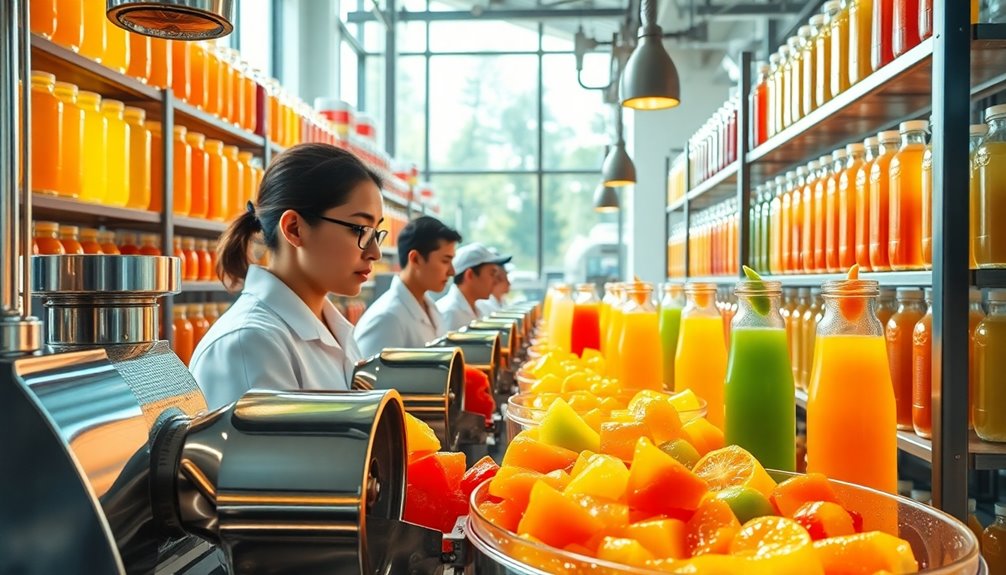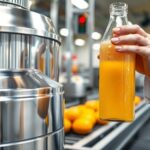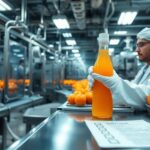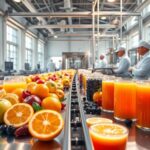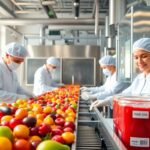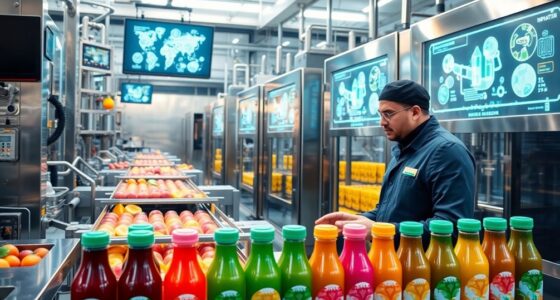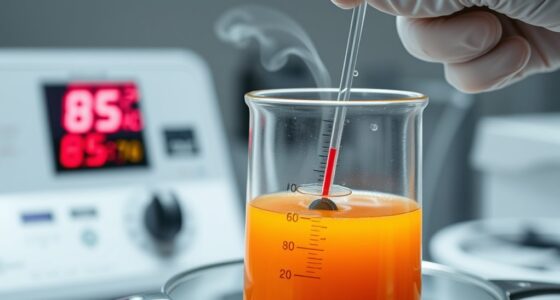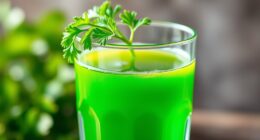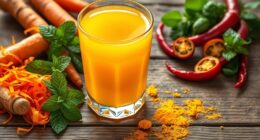To achieve ideal juice production, focus on six key practices. Start by implementing energy-efficient technologies and optimizing raw material usage to maintain quality. Don't forget to adopt water conservation techniques to minimize waste. Integrate effective waste management strategies while continuously monitoring your production processes for improvements. Finally, prioritize employee training on best practices to enhance overall efficiency. Discover even more strategies to elevate your juice production journey ahead!
Key Takeaways
- Implement energy-efficient technologies and equipment to reduce electricity consumption and enhance overall production efficiency.
- Utilize water conservation techniques, such as recycling systems and drip irrigation, to minimize water usage during juice production.
- Continuously monitor production processes using IoT-enabled sensors to ensure optimal extraction and maintain juice quality.
- Establish rigorous quality assurance protocols, including regular testing for acidity and sugar content, to uphold product standards.
- Preserve nutritional integrity by employing cold-pressing methods and training staff on the importance of nutrient retention throughout processing.
Implementing Energy-Efficient Technologies

As juice production becomes increasingly competitive, you can't afford to overlook energy-efficient technologies. By upgrading your extraction and processing equipment, you can cut down on electricity consumption considerably—consider that motors account for 48% of total energy usage in the beverage industry.
For instance, processing 10 tonnes of orange juice typically consumes around 11,196.5 MJ; implementing energy-efficient technologies can drastically reduce this figure. Utilizing variable frequency drives (VFDs) enhances motor operations, improving efficiency by ensuring they only operate at necessary load requirements.
Incorporating renewable energy sources like solar or wind power further decreases reliance on conventional energy, boosting your bottom line. Regular maintenance and calibration of your machinery will also help maintain peak performance and limit energy wastage, positively impacting your environmental footprint.
Optimizing Raw Material Usage
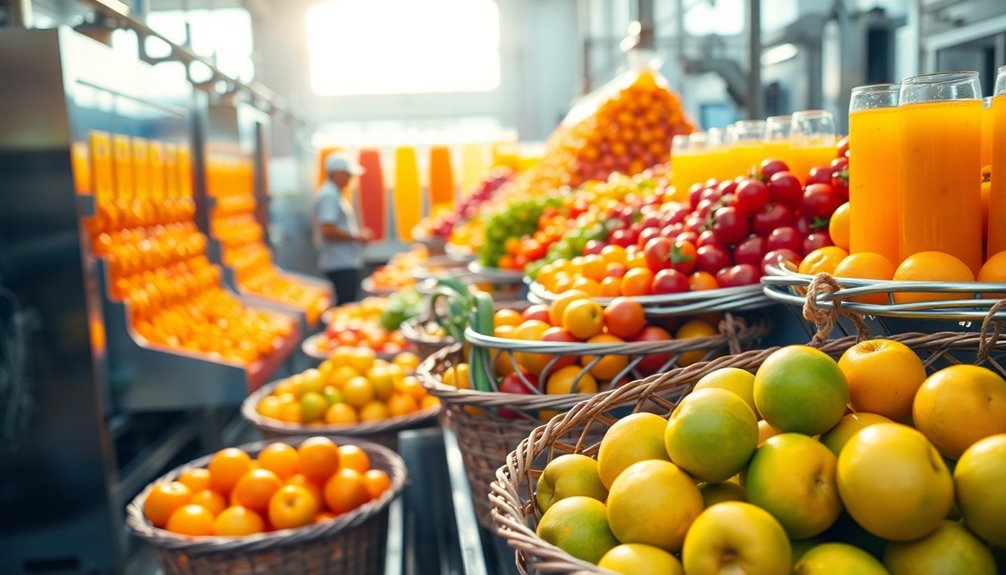
To produce high-quality juice, selecting fresh, ripe fruits and vegetables is essential since the quality directly impacts both the nutritional value and taste.
Here are some effective strategies for optimizing raw material usage:
- Establish partnerships with reliable suppliers for consistent quality.
- Conduct thorough quality checks upon delivery to minimize waste.
- Monitor seasonal availability to adjust sourcing strategies.
- Implement traceability of raw materials from farm to production.
Additionally, utilizing fresh ingredients can enhance both flavor and nutrition, ensuring a superior juice product.
Adopting Water Conservation Techniques

Water conservation techniques are vital in juice production, not just for environmental sustainability but also for reducing operational costs. Implementing water recycling systems can cut your overall water consumption by up to 50%, greatly lowering expenses.
Utilizing drip irrigation for raw material cultivation enhances water efficiency, delivering moisture directly to plant roots while minimizing evaporation. Regular audits of water usage can pinpoint areas for improvement, saving up to 30% in processing.
Installing low-flow fixtures and automated monitoring helps reduce water waste, ensuring usage only when necessary. Training your staff on these practices fosters a culture of efficiency, which is essential for maintaining food safety and minimizing nutrient loss.
Embracing these techniques not only benefits your bottom line but also supports a sustainable future.
Integrating Waste Management Strategies
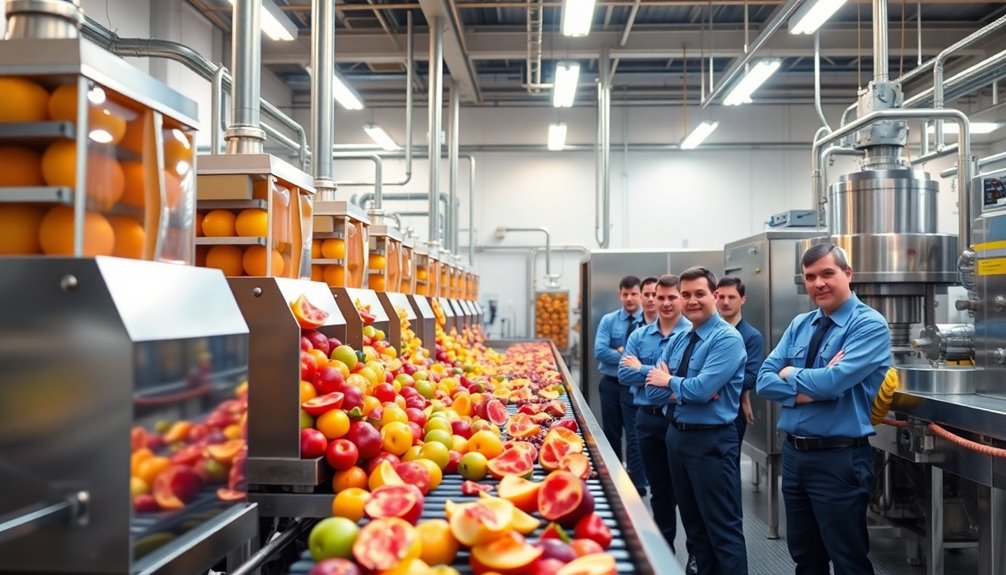
Effective waste management strategies are essential for sustainable juice production, especially since they directly impact both environmental and operational efficiency.
By integrating these practices, you can greatly reduce waste generation, lower CO emissions, and enhance your product's quality.
Here are some key strategies:
- Implement a Cleaner Production strategy to cut CO emissions by 20%.
- Establish partnerships for sourcing fresh, organic produce to reduce pesticide contamination.
- Conduct regular audits of waste management practices to identify inefficiencies.
- Invest in proper wastewater treatment systems to combat water pollution.
Additionally, considering the nutritional benefits of ingredients like chia seeds for weight loss can also contribute to healthier product offerings and reduced waste.
Continuous Monitoring of Production Processes
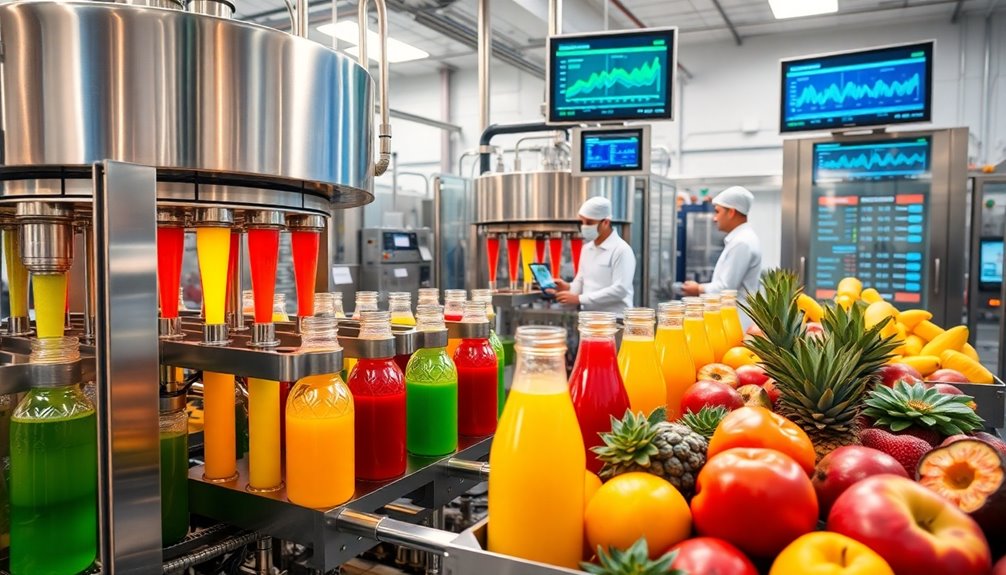
To maintain peak efficiency in juice production, you need to focus on real-time process tracking.
By leveraging data-driven decision making, you can quickly identify issues and implement quality assurance protocols that guarantee consistent product excellence. This proactive approach not only boosts output but also supports your sustainability goals. Additionally, conducting quality control tests on raw materials ensures safety and enhances the overall quality of the juice produced.
Real-time Process Tracking
As juice production demands precision, real-time process tracking plays an essential role in ensuring ideal extraction and quality. By continuously monitoring critical parameters like temperature, pressure, and flow rate, you can make immediate adjustments that enhance efficiency.
Here are some key benefits:
- Minimize downtime by quickly responding to deviations.
- Reduce waste and energy consumption with IoT-enabled sensors.
- Boost yield using data analytics tools to identify bottlenecks.
- Ensure compliance with safety and environmental regulations.
Real-time process tracking not only helps maintain consistency in product quality but also supports your sustainability initiatives. Additionally, maintaining optimal air quality is vital for preserving juice freshness during production and storage.
Data-Driven Decision Making
While continuous monitoring of production processes is essential for maintaining quality, it also empowers you to make data-driven decisions that enhance efficiency. By collecting real-time data, you can quickly address deviations from quality standards, ensuring product integrity.
Implementing data analytics tools helps identify trends in resource consumption, allowing you to optimize raw material usage and effectively reduce waste. Tracking energy consumption patterns reveals inefficiencies, enabling informed decisions that cut energy costs, a significant portion of operational expenses.
Regularly analyzing production data also assesses cleaner production strategies, promoting ongoing improvements and regulatory compliance. Additionally, utilizing data-driven decision-making supports predictive maintenance, minimizing downtime and ensuring consistent production output, ultimately enhancing overall operational efficiency. Moreover, understanding the nutritional advantages of green juice can guide product development towards healthier offerings, attracting health-conscious consumers.
Quality Assurance Protocols
Implementing robust quality assurance protocols is essential for ensuring that every batch of juice meets safety and quality standards. By continuously monitoring your production processes, you can enhance the freshness and shelf life of fresh juice while adhering to industry requirements.
Key practices include:
- Regular testing for acidity and sugar content
- Continuous monitoring of extraction parameters like temperature
- Routine audits of sanitation and hygiene
- Utilizing statistical process control for real-time quality tracking
These measures help you prevent contamination and maintain compliance with health regulations. Additionally, incorporating fresh organic ingredients can significantly improve the nutritional value of your juice products.
Documenting your quality control results not only provides traceability but also boosts consumer confidence in your juice products.
Prioritizing quality assurance is your path to delivering safe, high-quality fresh juice every time.
Employee Training on Best Practices

To guarantee the highest quality juice, you need to prioritize employee training on hygiene practices and equipment operation.
Teaching your staff proper sanitation techniques prevents contamination and maintains product safety.
Additionally, clear instruction on using juicers effectively will enhance efficiency and preserve nutrient content. Regular training on sanitation techniques ensures that your team remains updated on best practices for maintaining a clean and safe juice production environment.
Hygiene Practices Training
Ensuring a clean and safe production environment hinges on effective hygiene practices training for all employees.
It's important to use regular training sessions to reinforce sanitation protocols and minimize contamination risks.
Employees must be educated on the following key aspects:
- Thoroughly washing fruits and vegetables to eliminate pesticides and dirt
- Proper handwashing techniques using antibacterial soap and sanitizers
- Correct use and maintenance of cleaning equipment and sanitizing agents
- Routine audits and feedback mechanisms to uphold standards
Equipment Operation Instruction
Effective equipment operation is crucial for producing high-quality juice, and training your team on best practices is fundamental. Ascertain all employees understand how to operate high-quality bottling machines designed for food-grade materials, meeting safety and hygiene standards.
Emphasize regular maintenance and calibration of juicing equipment to optimize performance and safeguard juice quality. Provide training on sanitation practices to maintain a clean production environment, reducing contamination risks during juicing.
Instruct your team on appropriate extraction methods, like cold-pressing, to minimize oxidation and preserve nutritional integrity. Additionally, implement a quality control protocol where employees regularly test juice for acidity and sugar content, guaranteeing compliance with established quality standards throughout production.
This thorough approach will enhance your juice production process.
Frequently Asked Questions
What Is the 80/20 Rule for Juicing?
The 80/20 rule for juicing suggests you should use 80% vegetables and 20% fruits in your blends.
This balance helps you maintain a healthy nutrient profile while keeping sugar content low, which is essential for weight management and blood sugar control.
What Are the Steps of Juice Production?
When you think about juice production, it all starts with selecting fresh, ripe fruits and veggies.
You'll then guarantee proper sanitation to keep everything clean.
Next, you extract the juice using methods like cold-pressing.
After that, you'll conduct quality control tests for acidity and safety.
Finally, you package the juice in a temperature-controlled environment, making certain it's labeled correctly.
Each step's essential for delivering that fresh, delicious juice you love.
What Fruits Should Not Be Juiced Together?
When you're juicing, avoid mixing high-sugar fruits like bananas or grapes with starchy veggies such as carrots or potatoes, as this can cause bloating.
Melons should be juiced alone since they digest quickly.
Acidic fruits like oranges or pineapples don't pair well with sweet fruits because their acidity can upset your stomach.
Finally, combining apples or pears with cruciferous veggies can lead to gas and discomfort, so it's best to keep those separate.
What Is the 5 Log Pathogen Reduction Standard?
The 5 Log Pathogen Reduction Standard requires you to achieve a 99.999% reduction in harmful pathogens in juice products.
It's essential for ensuring safety and minimizing the risk of foodborne illnesses like E. coli and Salmonella.
You can accomplish this through methods like pasteurization or high-pressure processing, which are endorsed by regulatory bodies such as the FDA.
Meeting this standard not only protects consumers but also helps you comply with food safety regulations.
Conclusion
By embracing these top six practices, you’re not just optimizing your juice production—you’re setting free a juice-making revolution! Imagine transforming your facility into a powerhouse of efficiency, where every drop of juice is a triumph of sustainability. You’ll save money, conserve resources, and even impress your customers with your eco-friendly prowess! So, roll up your sleeves, plunge into these strategies, and watch as your juice production soars to legendary heights. The future of juice is in your hands! As you implement these juice production optimization techniques, you’ll quickly notice a marked improvement in both output and quality. By leveraging innovative technologies and sustainable practices, you can streamline processes while also enhancing flavor profiles that will keep your customers coming back for more. Embrace this opportunity to lead the industry towards a greener future, where your commitment to excellence and environmental stewardship shines brightly.
Cindy thoroughly researches juicing trends, techniques, and recipes to provide readers with practical advice and inspiration. Her writing style is accessible, engaging, and designed to make complex concepts easy to understand. Cindy’s dedication to promoting the advantages of juicing shines through her work, empowering readers to make positive changes in their lives through the simple act of juicing.

